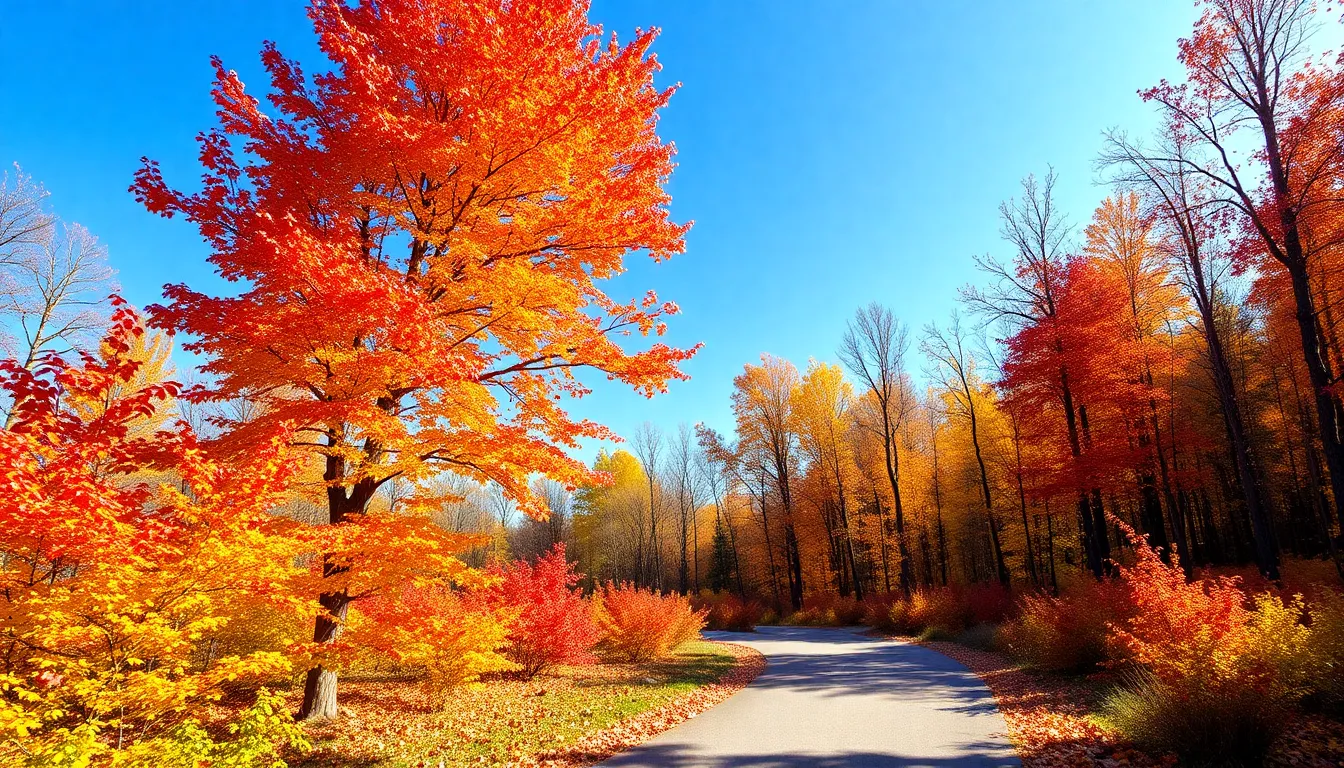Table of Contents
ToggleAs summer waves goodbye and the crisp air of autumn rolls in, nature prepares for its annual showstopper: the fall foliage. But wait! How do you catch the peak colors without playing a game of “guess the leaf”? Enter the fall foliage prediction map for 2024—your ultimate guide to witnessing Mother Nature’s vibrant transformation.
Overview of Fall Foliage
Fall foliage transforms landscapes into vibrant displays of color. In 2024, the fall foliage prediction map provides specific guidance about the best times and locations to witness these stunning changes. Peak foliage typically occurs at different times across regions, influenced by temperature and moisture levels.
Map data indicates that northern areas tend to see color changes earlier, usually from late September to mid-October. Southern climates often experience peak hues later, typically from mid-October to early November. Leaf colors are determined by factors like tree species, weather patterns, and daylight hours.
Widespread species such as maples, oaks, and birches contribute significantly to fall color. Maples often exhibit fiery reds and oranges, while oaks range from rich browns to muted yellows. This diversity enhances the overall beauty of autumn leaves, creating a breathtaking canvas for outdoor enthusiasts.
Engaging with local organizations and national park services offers additional insights into local foliage conditions. Many parks provide updates that can help visitors plan their trips effectively. Online platforms also feature user-generated content showcasing real-time foliage conditions, allowing for informed decisions.
People interested in fall foliage can benefit from using the prediction map. The map’s data helps identify peak viewing times, making it easier for travelers to enjoy nature’s spectacle. Tracking foliage trends throughout the season can lead to memorable experiences in beautiful settings.
Importance of Fall Foliage Prediction

Understanding fall foliage prediction significantly enhances the experience of enjoying autumn’s vibrant colors. By knowing when to visit specific areas, viewers can optimize their trips to capture the peak beauty of nature’s transformation.
Factors Influencing Color Change
Temperature and moisture levels directly influence the timing and intensity of color changes in leaves. Various tree species contribute unique hues, with maples showcasing bright reds and yellows, while oaks display richer browns and oranges. Geographic location also plays a role, as northern regions experience earlier color changes than southern areas. Soil conditions and elevation contribute to this phenomenon, impacting how quickly leaves transition to their fall colors.
The Role of Weather Patterns
Weather patterns significantly affect the fall foliage season’s vibrancy and timing. A warm summer followed by cool nights tends to enhance color intensity. Sufficient moisture throughout the growing season results in more vibrant hues. Conversely, drought conditions can cause leaves to change earlier and duller. Storms and high winds can also lead to premature leaf drop, making the prediction map even more vital for planning optimal viewing times.
Fall Foliage Prediction Map 2024
The Fall Foliage Prediction Map for 2024 serves as a vital resource for planning autumn outings. This tool helps viewers anticipate the optimal times to experience the vibrant transformations of trees.
Features and Innovations
The map incorporates advanced climate models to offer accurate predictions. Real-time updates provide the latest information on foliage conditions. Users can find interactive elements that allow for localized viewing, enabling exploration of specific regions. Additionally, it features an intuitive design that simplifies navigation. This includes color coding to indicate peak foliage stages, which adds to the user experience. Specific layering options let individuals track weather impacts and historical patterns, deepening the understanding of seasonal changes.
How to Interpret the Map
Interpreting the map depends on understanding its color coding. Each color represents different stages of foliage change, ranging from green for early leaf development to bright red for peak foliage. Users should take note of the timeline indicated to identify the best viewing periods. Familiarity with regional variations is essential; northern areas often show changes earlier than southern counterparts. It’s crucial to consider weather impacts communicated through the map, as local conditions can affect timing. Observing proposed viewing periods can help optimize travel plans for fall foliage enthusiasts.
Best Locations to Experience Fall Foliage
New England ranks as one of the top destinations for fall foliage. States like Vermont, New Hampshire, and Massachusetts showcase vibrant colors, particularly in late September and early October.
The Appalachian Mountains provide stunning vistas, especially in areas like West Virginia and North Carolina. Peak foliage here typically occurs from mid-October to early November, allowing visitors to enjoy breathtaking views and scenic drives.
The Great Smoky Mountains stand out for their diverse tree species. Visitors might experience striking color variations throughout October, creating a picturesque backdrop for hikes and photography.
Additionally, the Midwest offers unique foliage experiences. Locations such as the Door County in Wisconsin and the Michigan Upper Peninsula present striking shades of orange, red, and yellow, typically peaking in early October.
In the West, locations like Aspen, Colorado live up to their namesake. Golden aspen trees blanket the landscape in September and early October, attracting nature lovers and outdoor enthusiasts.
Along the West Coast, areas like the Columbia River Gorge in Oregon exhibit exceptional fall colors during late October. Far into the fall season, contrasting views of cliffs and rivers enhance the foliage experience.
Finally, areas in the Pacific Northwest, particularly the North Cascades, present vivid reds and yellows against stunning mountain backdrops. Visitors usually find peak colors between mid-October and early November, culminating in a remarkable visual experience.
Traveling to these recommended locations during peak foliage periods guarantees stunning displays of autumn’s beauty. Fall foliage enthusiasts should refer to the Fall Foliage Prediction Map for precise timing and planning.
The Fall Foliage Prediction Map for 2024 is an essential tool for anyone looking to immerse themselves in the vibrant colors of autumn. By understanding the timing and factors that influence foliage changes, enthusiasts can maximize their viewing experiences. Whether exploring the breathtaking landscapes of New England or the stunning vistas of the West, planning around peak foliage periods enhances the enjoyment of this natural spectacle. With real-time updates and interactive features, the map ensures that travelers can stay informed and make the most of their autumn adventures. Embracing the beauty of fall foliage not only enriches the season but also creates lasting memories.




